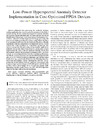Identificador persistente para citar o vincular este elemento:
https://accedacris.ulpgc.es/jspui/handle/10553/114223
| Título: | Low-power hyperspectral anomaly detector implementation in cost-optimized FPGA devices | Autores/as: | Caba, Julián Díaz Martín, María Barba Romero, Jesús Guerra Hernández, Raúl Celestino Escolar, Soledad López Suárez, Sebastián |
Clasificación UNESCO: | 3307 Tecnología electrónica | Palabras clave: | Anomaly Detection FPGA High-Level Synthesis Hyperspectral Imaging Line-By-Line Performance, et al. |
Fecha de publicación: | 2022 | Publicación seriada: | IEEE Journal of Selected Topics in Applied Earth Observations and Remote Sensing | Resumen: | Onboard data processing for on-the-fly decision-making applications has recently gained momentum in the field of remote sensing. In this context, hyperspectral anomaly detection has received a special attention since its main purpose lays on the identification of abnormal events in an unsupervised manner. Nevertheless, onboard real-time hyperspectral image processing still poses several challenges before becoming a reality. This is why there is an emerging trend towards the development of hardware-friendly algorithmic solutions embedded in reconfigurable devices. In this context, this work contributes with a hardware architecture that ensures a progressive line processing in time-sensitive applications limited by the scarcity of hardware resources. In this sense, we have implemented the state-of-the-art HW-LbL-FAD detector on a reconfigurable hardware for a real-time performance. Specifically, we have selected a cost-optimized FPGA (ZC7Z020-CLG484) to implement our solution whose results draw up a good trade-off between the following three features: time performance, energy consumption and cost. The experimental results indicate our hardware component is able to process hyperspectral images of 825x1024 pixels and 160 bands in 0.51 seconds with a power-budget of 1.3 watts and a device cost around 150 C. Regarding detection performance, the HW-LbL-FAD algorithm outperforms other state-of-the-art algorithms. | URI: | https://accedacris.ulpgc.es/handle/10553/114223 | ISSN: | 1939-1404 | DOI: | 10.1109/JSTARS.2022.3157740 | Fuente: | IEEE Journal of Selected Topics in Applied Earth Observations and Remote Sensing [ISSN 1939-1404], v. 15, p. 2379-2393, (Enero 2022) |
| Colección: | Artículos |
Citas SCOPUSTM
13
actualizado el 08-jun-2025
Citas de WEB OF SCIENCETM
Citations
12
actualizado el 08-jun-2025
Visitas
32
actualizado el 10-jun-2023
Descargas
19
actualizado el 10-jun-2023
Google ScholarTM
Verifica
Altmetric
Comparte
Exporta metadatos
Los elementos en ULPGC accedaCRIS están protegidos por derechos de autor con todos los derechos reservados, a menos que se indique lo contrario.
